Our Accelerating Universe
December 16, 2019
One interesting, and certainly
non-intuitive, aspect of
quantum mechanics is the
idea of
wave function collapse when doing
measurements. Quantum systems are fuzzy systems in which their
states exist in a
superposition; that is, there is no
yes or
no but
yes and
no at the same time. It's only when a
human decides to take a closer look that this fuzzy system collapses into a definite
yes or
no. In 1935,
physicist,
Erwin Schrödinger (1887-1961),
published a
thought experiment critical of this concept. His thought experiment, now called
Schrödinger's cat, subjects a
cat to the result of a quantum
experiment with the result that it's both
dead and alive until someone checks its state.
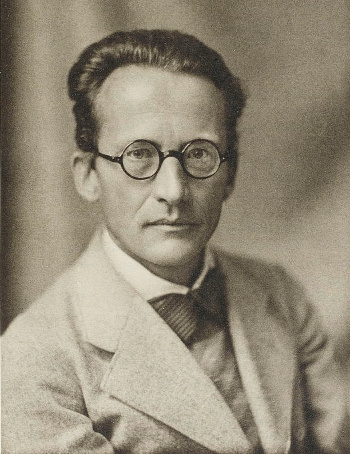
Erwin Schrödinger (1887-1961) in 1933 in his official Nobel Prize portrait.
Some people think that scientists lead boring lives, but Schrödinger's personal life was quite exciting.
He lived in the same house with both his wife and a mistress, and he fathered a child with the mistress. He fathered another two children with two other women.
Schrödinger, who was an atheist, was buried in a Catholic cemetery in Alpbach, Austria, since he was a member of the Pontifical Academy of Sciences.
(Wikimedia Commons image.)
Something
analogous to wavefunction collapse after measurement happened in
cosmology. The
universe has been
physically expanding for nearly 14 billion years since the
Big Bang, but it's only been expanding as far as humans are concerned for about a century. A
century ago
astronomers thought that the full extent of the
universe was our
Milky Way galaxy. While this seems to minimize the idea of what a universe should be, the Milky Way has between 100 and 400 billion
stars, and it exists in a 150-200 thousand
light year region of
space. Space beyond the Milky Way was thought to be
empty.
The first evidence pointing to something that might spoil this simple
model was the
observation of unusual objects that were known as
spiral nebulae. The nature of these objects was addressed by two prominent astronomers in the "
Great Debate" of April 26, 1920, at the
Smithsonian Museum of Natural History.
Director of the
Harvard College Observatory,
Harlow Shapley (1885-1972),
debated the nature of these objects with
Heber Curtis (1872-1942), a past
president of the
Astronomical Society of the Pacific and director of the
Allegheny Observatory.
Curtis thought that the spiral nebulae were large and distant independent galaxies, while Shapley argued that the nebulae were just objects at the
periphery of the Milky Way. We now know that Curtis was correct,since we live in a universe nearly a hundred billion light years in size that may contain a trillion galaxies. Further observation of these galaxies external to our Milky Way has shown that the universe exists, not in a
steady state, but in a
state of expansion.
American astronomer,
Edwin Hubble (1889-1953) quantified this expansion in the eponymous
Hubble's law, which expresses the rate of
expansion of the universe.
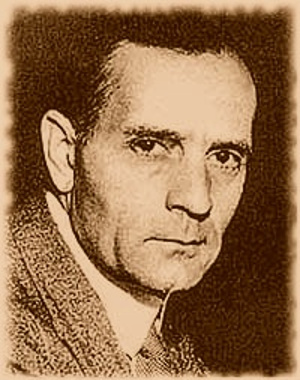
Edwin Hubble (1889-1953)
Hubble was not a household name until the Hubble Space Telescope (HST) was launched in 1990.
The Nobel Prize was withheld from astronomers during Hubble's lifetime because of a narrow interpretation of the prize requirement that it be given to 'those who, during the preceding year, shall have conferred the greatest benefit on mankind'; but, as astronomers started answering some important questions in physics, that changed.
(Photograph via Wikimedia Commons, modified for artistic effect.)
While Hubble is
renowned for discovery of universal expansion,
Belgian priest and astronomer,
Georges Lemaître, discovered this law before Hubble. However, he published his 1927 paper on this idea in
French in a lesser known
journal where it was ignored.[1] Lemaître's used
data taken by astronomer,
Vesto Slipher, to
calculate what is now called the
Hubble constant to be 625
kilometers-per-second-per-
megaparsec (km/s/Mpc). Hubble's 1929 paper, which didn't reference Lemaître's paper since he likely had never seen it, contained additional data and gave a Hubble constant of 500 km/s/Mpc. Today, the accepted value is a much smaller 75 km/s/Mpc.
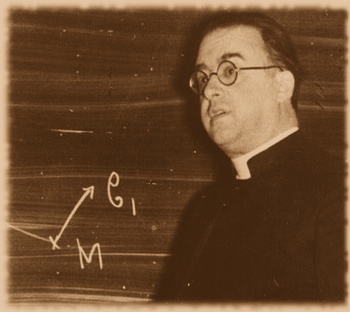
Georges Lemaître (1894-1966)
A 91 kilometer diameter lunar crater at 61.2°S, 149.6°W is named after Lemaître, as was an unmanned spacecraft, the Georges Lemaître Automated Transfer Vehicle 5.
This spacecraft ferried nearly seven tons of equipment and supplies to the International Space Station in 2014.
(Photograph via Wikimedia Commons, modified for artistic effect.)
As I wrote in a
previous article (Hubble and His Law, July 31, 2013), noted astronomer,
Virginia Trimble, listed quite a few precursors other than Lemaître to Hubble's law in an
arXiv article.[2]
• Knut Lundmark, who was one of the first to work on the hypothesis that galaxies were not part of the Milky Way by measuring the distance to the Andromeda Galaxy in 1919.
• Willem de Sitter, who created a relativistic mathematical model for a universe that allows for expansion.
• Vesto Slipher, who discovered galactic redshifts. Lemaître used Slipher's data in his 1927 paper.
• Alexander Friedmann, whose 1922 Friedmann equations provided a model for an expanding universe.
• Carl Wilhelm Wirtz, who observed galactic redshifts in 1918, but only publishing his results in 1922.
• Johann Karl Zoellner, who also worked on redshifts.
One major advance in the determination of the Hubble constant and the large-scale structure of the universe was the discovery in 1964 of
cosmic microwave background radiation by
Arno Penzias and
Robert Wilson. This radiation at
microwave frequencies is the remnant of a
very early stage of the universe that occurred about 0.4 million years after the
Big Bang; that is, 0.03% into the present
age of the universe. This microwave background radiation was measured in great detail by the
Cosmic Background Explorer satellite,[3] and it corresponds to a
thermal black body spectrum at a
temperature of about 2.725 K.
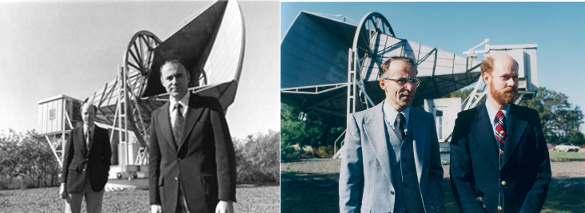
Arno Penzias (right image, left) and Robert Wilson (right image, right), standing at the horn antenna with which they discovered the cosmic microwave background radiation. The left image was taken at the time of the discovery, while the right image was taken in 1978 at the time of their award of the Nobel Prize in Physics. (Left image, via Wikimedia Commons. Right image, compliments of the Bell Labs archives.)
Scientists are always interested in more
precise values for any of their
fundamental physical constants, and the Hubble constant is no exception. Over the course of years they've found that the universe is not just expanding, but that the
expansion is accelerating. This wasn't discovered until 1998 during Hubble constant measurements with
type Ia supernovae, a "
standard candle" for determination of distance by their
luminosity. Prior to that discovery, the common view was that the expansion should be decelerating, instead, as a consequence of
gravitation. The current model for this expansion is the
Lambda-CDM model (Λ-CDM) which incorporates the effects of
cold dark matter (CDM). The
Greek letter, Λ, is the common
symbol for the
cosmological constant that expresses the
energy density of space and accounts for
dark energy.
Still, the true picture of this accelerating expansion is not entirely clear.[4-10] Early this year, a team of astronomers used the
Hubble Space Telescope to determine the Hubble constant by observing 70 long-period
Cepheids in the
Large Magellanic Cloud.[4-5] They found that the Hubble constant was 74.22 ± 1.82 km/s/Mpc. Combined with data from the
Araucaria Project, a project that made precise distance measurements of the Large Magellanic Cloud, gave 74.03 ± 1.42 km/s/Mpc.[4-6] The problem is that the constant measured this way is significantly different from that inferred from the cosmic microwave background data for the early universe found by the
Planck spacecraft and the Lambda-CDM model.[4-5] The difference is 6.6±1.5 km/s/Mpc, which is at a 4.4
sigma significance level that suggests that the result is not
chance.[4-5]
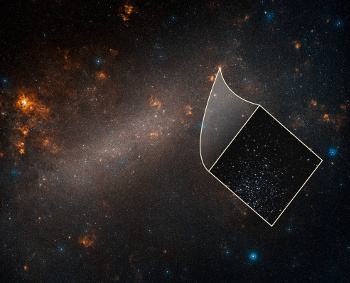
Ground-based telescope's view of the Large Magellanic Cloud with an inset image by the Hubble Space Telescope.
The inset shows one of the many star clusters containing Cepheid variables in this satellite galaxy of our Milky Way.
(Images by NASA/ ESA,/A. Riess (STScI/JHU)/Palomar Digitized Sky Survey. Click for larger image.)
To put it another way, the chance that the discrepancy is false is just
one chance in a 100,000, so it seems certain that there's a faster expansion rate than expected from the Planck observations of the universe 13 billion years ago.[6-7] Says the lead
author,
Adam Riess, who is at the
Space Telescope Science Institute (STScI) and
Johns Hopkins University (Baltimore, Maryland),
"The Hubble tension between the early and late universe may be the most exciting development in cosmology in decades... This mismatch has been growing and has now reached a point that is really impossible to dismiss as a fluke. This disparity could not plausibly occur just by chance... "This is not just two experiments disagreeing... We are measuring something fundamentally different. One is a measurement of how fast the universe is expanding today, as we see it. The other is a prediction based on the physics of the early universe and on measurements of how fast it ought to be expanding. If these values don't agree, there becomes a very strong likelihood that we're missing something in the cosmological model that connects the two eras."[6]
This discrepancy has been confirmed by a recent study that measured the Hubble constant for three very distant
quasars, HE0435-1223, PG1115+ 080, and RXJ1131-1231, imaged by
gravitational lensing.[8-9] These were observed using the Hubble Space Telescope and an
adaptive optics telescope at the
W. M. Keck Observatory. The team conducted a
blind analysis, a method more common in
clinical trials than in observational astronomy.[8-9] The derived Hubble constant, 76.8+2.6−2.6 km/s/Mpc, is consistent with the Large Magellanic Cloud Cepheid study.[8-9] Both studies suggest that the universe is expanding more rapidly than predictions.[10]
There are several possibilities to explain the divergence of theory and these new observations. One involves an earlier emergence of dark energy than
theorized.[6] Dark energy is the presumed agent for universal expansion, it may interact more strongly with
normal matter or
radiation than previously thought, so it might also explain the acceleration.[6] There might also be an undiscovered
subatomic particle that travels close to the
speed of light that participates in
dark radiation interactions.[6-7]
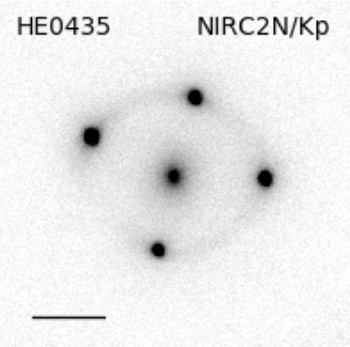
A good example of a gravitation lens.
This is an adaptive optics image of the gravitational lens system, he0435-1223, produced by a Keck Observatory telescope. The marker represents one arcsecond.
(Portion of fig. 1 from ref. 9.[9])
![]()
References:
- Jean-Pierre Luminet, "Editorial note to "A Homogeneous Universe of Constant Mass and Increasing Radius accounting for the Radial Velocity of Extra--Galactic Nebulae" by Georges Lemaître (1927)," arXiv, May 28, 2013.
- Virginia Trimble, "Anybody but Hubble!" arXiv, July 8, 2013.
- Sophia Chen, "Hubble Trouble: A Crisis in Cosmology?" APS News, vol. 27, no. 5 (May, 2018).
- Adam G. Riess, Stefano Casertano, Wenlong Yuan, Lucas M. Macri, and Dan Scolnic, "Large Magellanic Cloud Cepheid Standards Provide a 1% Foundation for the Determination of the Hubble Constant and Stronger Evidence for Physics Beyond LambdaCDM," The Astrophysical Journal, vol. 876, no. 1 (May 7, 2019), https://doi.org/10.3847/1538-4357/ab1422.
- Adam G. Riess, Stefano Casertano, Wenlong Yuan, Lucas M. Macri, and Dan Scolnic, "Large Magellanic Cloud Cepheid Standards Provide a 1% Foundation for the Determination of the Hubble Constant and Stronger Evidence for Physics Beyond LambdaCDM," arXiv, March 27, 2019.
- Rob Garner, "Mystery of the Universe’s Expansion Rate Widens With New Hubble Data," NASA Goddard Press Release, April 25, 2019.
- Latest Hubble Measurements Suggest Disparity in Hubble Constant Calculations is not a Fluke, heic1908 — Science Release, spacetelescope.org, April 25, 2019.
- Geoff C.-F. Chen, Christopher D. Fassnacht, Sherry. H. Suyu, Cristian E. Rusu, James H. H. Chan, Kenneth C. Wong, Matthew W. Auger, Stefan Hilbert, Vivien Bonvin, Simon Birrer, Martin Millon, Leon V. E. Koopmans, David J. Lagattuta, John P. McKean, Simona Vegetti, Frederic Courbin, Xuheng Ding, Aleksi Halkola, Inh Jee, Anowar J. Shajib, Dominique Sluse, Alessandro Sonnenfeld, and Tommaso Treu, "A SHARP view of H0LiCOW: H0 from three time-delay gravitational lens systems with adaptive optics imaging," Monthly Notices of the Royal Astronomical Society, vol. 490, no. 2 (December, 2019), pp.1743–1773, https://doi.org/10.1093/mnras/stz2547.
- Geoff C.-F. Chen, Christopher D. Fassnacht, Sherry. H. Suyu, Cristian E. Rusu, James H. H. Chan, Kenneth C. Wong, Matthew W. Auger, Stefan Hilbert, Vivien Bonvin, Simon Birrer, Martin Millon, Leon V. E. Koopmans, David J. Lagattuta, John P. McKean, Simona Vegetti, Frederic Courbin, Xuheng Ding, Aleksi Halkola, Inh Jee, Anowar J. Shajib, Dominique Sluse, Alessandro Sonnenfeld, and Tommaso Treu, "A SHARP view of H0LiCOW: H0 from three time-delay gravitational lens systems with adaptive optics imaging," arXiv, July 4, 2019.
- A Crisis in Cosmology, W. M. Keck Observatory Press Release. October 22, 2019.
Linked Keywords: Intuition; quantum mechanics; idea; wave function collapse; measurement in quantum mechanics; quantum state; quantum superposition; human; physicist; Erwin Schrödinger (1887-1961); scientific literature; publish; thought experiment; Schrödinger's cat; cat; experiment; death; dead; Nobel Prize portrait; scientist; boredom; boring; Schrödinger's personal life; house; wife; mistress (lover); father; child; women; atheism; atheist; Catholic Church; cemetery; Alpbach, Austria; Pontifical Academy of Sciences; Wikimedia Commons; analogy; analogous; physical cosmology; universe; expansion of the universe; physically expanding; Big Bang; century; astronomer; Milky Way; galaxy; star; light year; space; vacuum; conceptual model; observational astronomy; spiral nebula; Great Debate (astronomy); Smithsonian Museum of Natural History; director; Harvard College Observatory; Harlow Shapley (1885-1972); debate; Heber Curtis (1872-1942); president; Astronomical Society of the Pacific; Allegheny Observatory; periphery; steady state; metric expansion of space; state of expansion; American; Edwin Hubble (1889-1953); Hubble's law; celebrity; household name; Hubble Space Telescope; rocket launch; Nobel Prize; physics; renowned; Belgian; priest; Georges Lemaître (1894-1966); French language; scientific journal; data; Vesto Slipher; calculation; calculate; kilometers-per-second; megaparsec; kilometer; diameter; lunar crater; spacecraft; Georges Lemaître Automated Transfer Vehicle 5; ton; scientific instrument; equipment; International Space Station; Virginia Trimble; arXiv; Knut Lundmark; hypothesis; Andromeda Galaxy; Willem de Sitter; theory of relativity; relativistic; mathematical model; redshift; Alexander Friedmann; Friedmann equations; Carl Wilhelm Wirtz; Johann Karl Zoellner; cosmic microwave background radiation; Arno Penzias; Robert Wilson; microwave; frequency; recombination (cosmology); very early stage of the universe; age of the universe; Cosmic Background Explorer; black-body radiation; thermal black body spectrum; temperature; horn antenna; Nobel Prize in Physics; Bell Labs; accuracy and precision; precise; fundamental physical constant; type Ia supernova; standard candle; luminosity; gravitation; Lambda-CDM model (Λ-CDM); cold dark matter (CDM); Greek letter; symbol; cosmological constant; energy density of space; dark energy; Cepheid variable; Large Magellanic Cloud; Araucaria Project; Planck spacecraft; standard deviation; sigma; statistical significance; significance level; randomness; chance; telescope; star cluster; odds; one chance in a 100,000; author; Adam Riess; Space Telescope Science Institute (STScI); Johns Hopkins University (Baltimore, Maryland); decade; coincidence; fluke; quasar; gravitational lens; gravitational lensing; adaptive optics; W. M. Keck Observatory; blinded experiment; blind analysis; clinical trial; theory; theorized; normal matter; electromagnetic radiation; subatomic particle; speed of light; dark radiation; arcsecond.